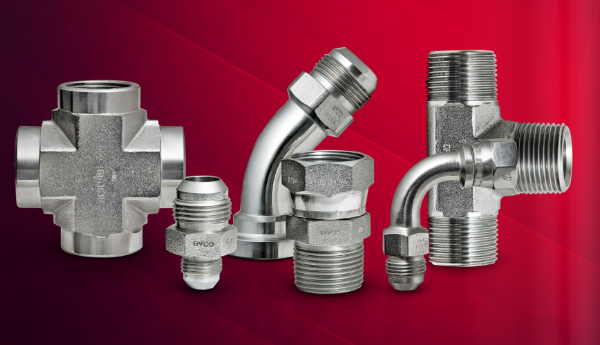Types of Hydraulic Fittings
To know which hydraulic hose fittings you require, you must first understand the two key functions of the fitting – simply to hold the hydraulic hose in the correct position in relation to the machine & sealing so no material can escape. Sometimes the holding and sealing functions are provided by the same mechanism or connector, and sometimes by two different parts.
Couplings can either be permanent or re-usable. Crimping the hose onto the coupling to become permanent is widely used, and is generally more reliable, easier and quicker as it comes pre-assembled. Re-usable or Field Attachable couplings fit right on the hose using a wrench and vice; while handy to interchange if parts become damaged – they cost more in time and money. There are 3 main types of hydraulic couplings.
.jpg)
Tapered threaded hydraulic connectors are the earliest fittings that were invented to join pipes together. This type of connector mates an external male thread (tapered) with an internal female thread (can be tapered or parallel) The disadvantage of this type of fitting is that mandatory sealant is required, and generally will break down after a period of time. However, they can be mechanically strong as they seal via the thread, and the thread being twice as long as other forms of connectors, holds a better seal.
.jpg)
Metal Seal connectors are next in line and were a better alternative to tapered threads with the invention of machining the face of the thread to 30 degree angle, to form a seat. This means the thread is now used for holding, while the angled machine face does the sealing. Disadvantages to this type of connector is that damage can occur on the sealing face, and then must be disposed of.
.jpg)
Soft Seal Connectors are the next development in the evolution and makes use of a rubber O-ring seal to prevent leakage. The soft seal also helps with vibration resistance, high pressure capabilities and are quick and easy to assemble and the seal can be replaced when worn.
Do not mix and match hoses and couplings from different manufacturers. As with choosing a hydraulic hose, you need to know what size, application, pressure, temperature and material is being transported through the coupling. It is best to talk to a hydraulic hose and coupling manufacturer or specialist to determine what coupling or adaptor you require. They will usually be able to assist you with a complete hose assembly, providing you with a new hose and couplings already attached, ready to be installed directly onto your machine.

